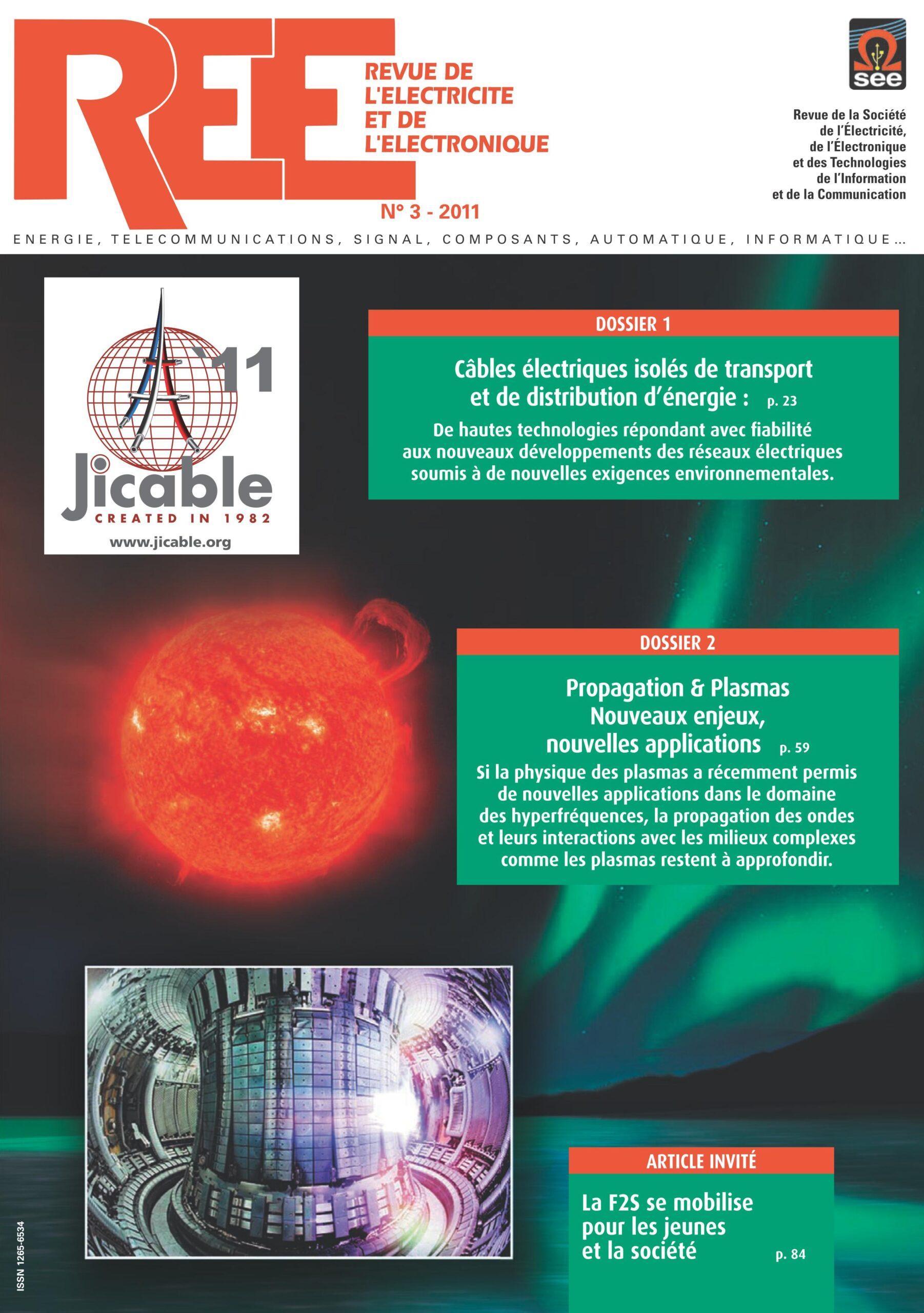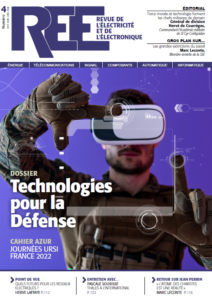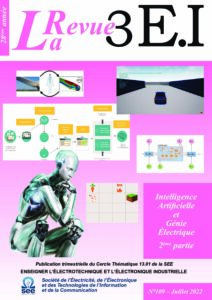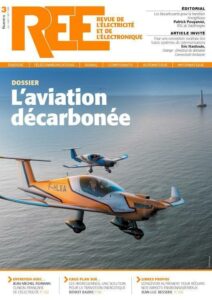Abonnez-vous

€18.00
Rupture de stock
REE 2011-3
Rubrique nouveaux produits préparée avec le soutien de
Dossier 1 : Transmission and Distribution Insulated Power Cables
Developments of the Underground MV Network à ERDF (France). Recap and Prospects
Jacques Merley
ERDF, Direction technique, Département développement du réseau, France
Keywords:
Development, MV Network, Quality, Renewable Production
Abstract
How to throw light on the challenges, over the next 10 to 15 years, of developing the MV network with regard to its overhead-underground structure? What are the major factors that will weigh on the development of resources of about 600 000 km of links which are now primarily overhead? From a review of the main external factors, increase in renewable production, control of service quality, etc., we can try to throw light on the most likely trends for the next 10 to 15 years.
Evolution of the Electric Power Transmission Grid: Challenges of the Underground Links
Jérôme HERREROS,
RTE, Réseau de Transport d’Electricité, Département Liaisons, France
KeyWords:
Underground Links, Technical Challenges, Economic Competitiveness, Environment, Safety
Abstract
This article gives a synthetic sightseeing of the evolution of the French Electric underground Transmission grid. Encountered stakes and challenges when developing the underground link are shown via an approach including the Environmental, Economical and Societal components of the Sustainable Development.
The evolution of equipments and methods of installation allow to fulfil new needs while ensuring the competitiveness of the Underground technique, and with high respect to the safety of Human Beings, equipments and the Environment.
Contribution of CIGRE SC B1 to the Evolution of HV/EHV Power Cable Systems
Pierre ARGAUT
CIGRE SC B1
Keywords:
Power Cables ; Accessories ; Diagnostics ; Design ; Construction ; Operation ; HVDC ; HVAC ; Life Cycle
Abstract
The field of activity of SC B1 is the development and operation of all types of AC and DC insulated cable systems for Land and Submarine Power Transmission. It is focused mainly on HV and EHV applications but MV cable applications are also considered.
The scope of work of SCB1 covers theory, design, applications, manufacture, installation, testing, operation, maintenance and diagnostics techniques of insulated cables. This paper describes the current and the future work of SC B1 for the coming years in line with the four Technical Directions adopted by the Technical Committee of CIGRE.
Beyond Standards, FIRE
Arnaud Piechaczyk1, Aurélien THIRY2, Bernard Poisson3, Pascal Chopin4, Patrick Le Dirat5, Roland Bail6, Sabrina Fell7, Sylvie Barbazanges8
Nexans Research Center1, French Central Laboratory of Police Prefecture (LCPP)2, Silec Cable3, Acome4, Company General of Plastics (CGP) 5, Syndicat Professionnel des Fabricants de Fils et Câbles électriques (SycaBEL)6, Draka7, Prysmian8
Keywords:
Fire Spread, Fire Load, Cables, Smoke Opacity, Toxicity, Scale Effect
Abstract
Experience feedback on some fires such as Düsseldorf Airport and the National Library ones has shown that cables have been at least a propagation vector and/or have brought an important additional fire load. This article highlights the necessity to go beyond standards when approaching fire phenomena.
Life-size fire simulations, scale 1, realized by the LCPP teams in Arcueil or the Puy en Velay for example, allow to better explore the possibilities spectrum of a fire development. Data measured enrich and help validating numeral calculation tools, which play a part in the improvement of 3D simulation. This allows on one hand to improve fire effects prediction, and on the other hand, in case of a fire justifying an investigation, to check that scenarios suggested by the experts are relevant.
Normative tests carried out in laboratories and additional investigations which were conducted there allowed to define configurations to be selected to realize fire simulation comparative tests, scale 1, for low fire-hazard cables and standard cables.
These tests allowed estimating: flame propagation speed, temperatures and thermal radiation, smoke opacity …
All works realized highlighted the interest of low fire-hazard cables compared with standard cables in a real situation.
Dossier 2 : Plasma and Propagation: New Stakes, New Applications
EISCAT 3D: A Next Generation of Ionospheric Radars
Frédéric PITOUT
IRAP, CNRS/UPS, Toulouse
Keywords:
Polar Ionosphere, Auroral Zone, Space Weather, Radar, Observations
Abstract
The EISCAT incoherent scatter radars have been used successfully for 30 years to observe the auroral ionosphere but we know reach their limits, both technically and scientifically. In order to progress significantly in the fields of auroral electro- and thermodynamics, and to increase our surveillance, now- and forecasting capabilities for space weather, we need a higher-performance and more cost effective instrument. We are working on a new radar system, EISCAT 3D, based on the different technology: the phased array technique. This will allow us to obtain better time and spatial resolutions as well as new 3D sounding capabilities.
Detection of MHD Modes in Tore-Supra Tokamak with Reflectometry
Roland SABOT1, Zwinglio GUIMARAES-FILHO2, Christine NGUYEN3, Thomas RISTORCELLI1, Didier ELBEZE1, Xavier GARBET1, Jean-Claude GIACALONE1
CEA, IRFM1, PIIM, Université de Provence2, CPHT, École polytechnique3
Keywords:
Fusion Plasma Diagnostic, Reflectometry, MHD, Alfvén Instabilities
Abstract
Based on ionosphere radar, reflectometry is a diagnostic that measures the electron density in magnetic fusion devices. The high sensitivity and precision make reflectometry able to detect the density perturbations induced by MHD instabilities. Using plasma rotation, a 2-D image of the density profile can be reconstructed during sawtooth, a core MHD relaxation. Running in fixed frequency mode, reflectometers detect the cut-off layer oscillations induced by MHD modes as fast particles driven MHD modes. A good agreement was obtained between observations and theoretical predictions for acoustic MHD modes (Beta Alfvén Eigenmodes) which are excited by fast ions. However, the temporal evolution of the frequency and the structure (frequency splitting) of these modes during a sawtooth is under investigation.
Wide Band Analysis of Structures Containing Dispersive Plasma With the TLM Method
Arij Farhat, Michel Ney
Télécom Bretagne, Lab-STICC (UMR CNRS 3192)
Keywords:
Plasma, Transmission Line Matrix (TLM), Dispersive Media
Abstract
Our study is to adapt the TLM method to dispersive electromagnetic media, like plasmas, This article proposes a new general and systematic technique based on a pure field formulation [1] to account for presence of any type of material.
Articles de la revue
Produits similaires
-
€33.00
-
€30.00
-
€12.00
-
€30.00



